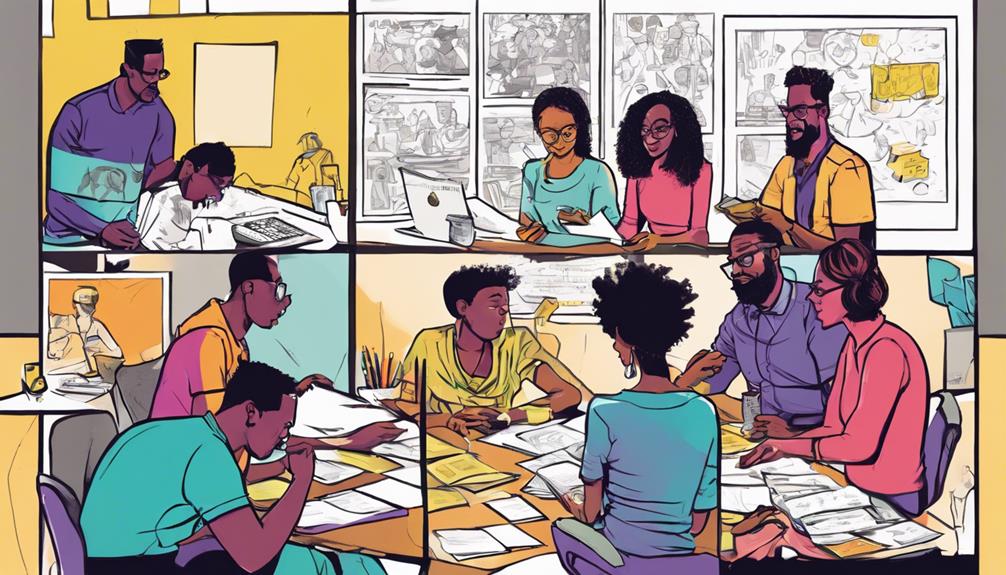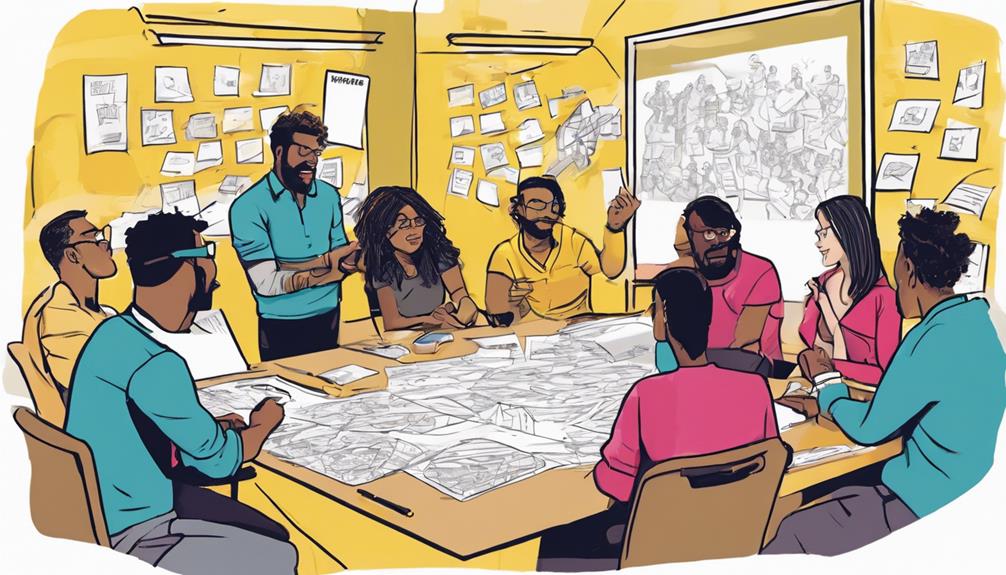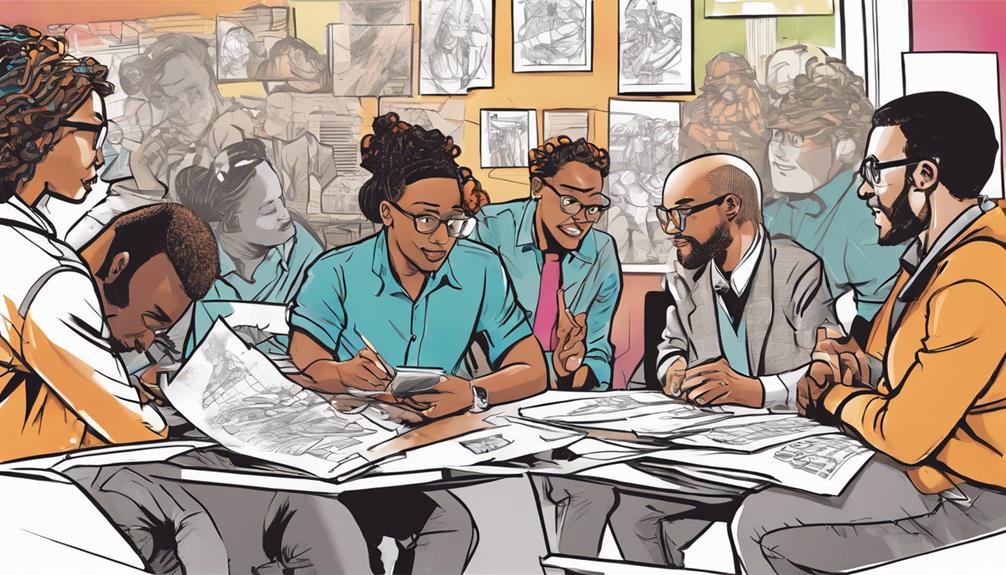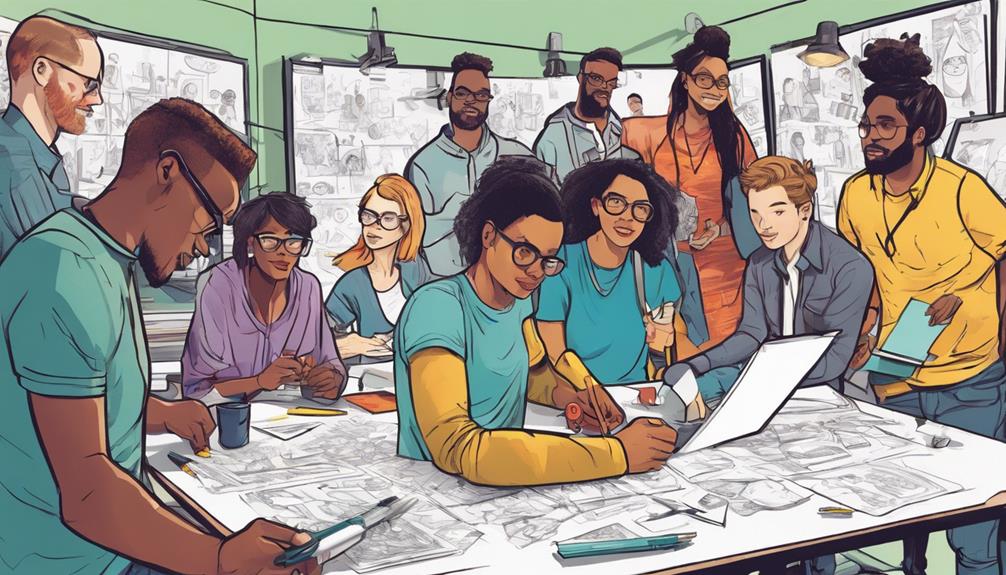Transform your ideas into reality with design thinking workshops! These workshops spark innovation, enhance problem-solving, and nurture collaboration. Through hands-on activities and expert facilitation, you'll see your ideas take tangible form. Immerse yourself in a creative journey that leads to groundbreaking solutions and increased success rates. Discover how these workshops unlock your team's full potential and drive positive change within your organization. Ready to witness the transformative impact of design thinking workshops on problem-solving and innovation?
Key Takeaways
- User-centered design principles drive workshop activities.
- Ideation techniques spark creative idea generation.
- Prototyping methods bring concepts to life for testing.
- Collaboration fosters diverse perspectives and innovative solutions.
- Rapid iteration mindset ensures quick and effective problem-solving.
Understanding Design Thinking
To grasp the essence of design thinking, explore its human-centered approach to tackling complex challenges. Design thinking is a process that revolves around developing creative solutions while keeping the end-user at the core of problem-solving.
This approach emphasizes understanding the needs and behaviors of users, defining the problems they face, brainstorming innovative solutions, creating prototypes, and testing these ideas in real-world scenarios.
By focusing on the human-centered approach, design thinking encourages individuals to be intuitive, open-minded, and inventive in their problem-solving endeavors. It fosters a collaborative environment where diverse perspectives come together to address challenges collectively.
This mindset shift towards collaborative problem-solving not only enhances the quality of solutions but also cultivates an innovative culture within teams and organizations.
Through design thinking workshops, participants can experience firsthand how this process can transform abstract ideas into tangible results within a few weeks. This hands-on approach enables individuals to practice the principles of design thinking and see its impact on problem-solving and creativity.
Key Elements of Design Thinking

You'll find that understanding the core design elements, recognizing the impact of workshops, and appreciating facilitator expertise are key aspects to ponder when delving into design thinking.
By focusing on these points, you can enhance your workshop experience and drive innovation effectively.
Embracing these key elements will help you transform your ideas into reality with confidence.
Core Design Elements
Design Thinking incorporates essential Core Design Elements that drive the innovation process forward efficiently and effectively. By focusing on user-centered design, innovative solutions that meet real user needs are developed, enhancing product relevance. Utilizing ideation techniques such as brainstorming and mind mapping unlocks creative potential, leading to the generation of diverse and forward-thinking ideas. Prototyping methods play a crucial role in enabling quick testing and iteration, which accelerates innovation cycles and ensures the development of effective solutions. Collaboration with diverse teams not only boosts creativity but also enhances problem-solving efficiency by leveraging different perspectives. Embracing a rapid iteration mindset is key to achieving quicker and more effective solutions, ultimately driving success in innovation endeavors.
| Core Design Elements | Description |
|---|---|
| User-Centered Design | Ensures solutions meet real user needs |
| Ideation Techniques | Foster creative idea generation |
| Prototyping Methods | Enable quick testing and iteration |
| Collaboration | Boosts creativity and problem-solving |
| Rapid Iteration Mindset | Leads to quicker and more effective solutions |
Workshop Impact
Engage in immersive Design Thinking workshops to experience firsthand the transformative impact of key elements on idea generation and problem-solving capabilities. These workshops serve as catalysts for transforming ideas into tangible results, providing a structured environment where collaboration is nurtured to address complex challenges effectively.
Through collaborative problem-solving, teams in workshops not only generate concrete ideas but also develop actionable outcomes that drive innovation within organizations. The workshop culture, emphasizing empathy, creativity, and strategic thinking, plays a pivotal role in fostering innovation and encouraging participants to think outside the box.
The tangible results achieved in Design Thinking workshops have a lasting impact, influencing not only the immediate problem-solving process but also contributing to broader organizational and community goals. By embracing a mindset shift towards collaborative problem-solving, participants can harness the power of workshops to drive positive change and create innovative solutions that address real-world challenges effectively.
Facilitator Expertise
Amplify the transformative potential of Design Thinking workshops by leveraging facilitator expertise as a key element in fostering innovation and collaborative problem-solving.
Workshops empower participants by bringing together diverse perspectives and skill sets under the guidance of a skilled facilitator like Dr. Malte Krohn, a Faculty Innovation Fellow at Stanford University's d.school. With degrees in Product Development and Global Innovation Management, Dr. Krohn has a wealth of experience in helping startups and multinational firms realize their ideas.
His co-development of an international masters program for innovation management showcases his commitment to nurturing creativity and strategic thinking. By leading design sprints and encouraging a human-first approach to innovation, facilitators like Dr. Krohn help participants gain a deeper understanding of user needs and business goals, ultimately driving the creation of impactful solutions.
In the hands of a knowledgeable facilitator, Design Thinking workshops become dynamic spaces where creativity flourishes and innovative ideas take shape.
Workshop Methodology and Process

Utilizing a structured methodology, the workshop guides participants through key stages focused on user-centered design principles.
The workshop methodology follows the Design Thinking framework, emphasizing problem definition, user research, ideation, prototyping, and experimentation.
Facilitators lead hands-on activities to translate ideas into tangible prototypes, ensuring a practical approach to solving complex challenges.
Design strategy techniques are employed to align solutions with organizational goals and user needs, allowing for the transformation of innovative ideas into reality.
This process of iterative development and testing is essential in addressing the multifaceted nature of today's complex challenges.
Workshop Facilitation and Expertise

With Dr. Malte Krohn's rich experience and educational background in innovation management, workshop facilitation at Stanford University's d.school is characterized by a human-centric approach. Dr. Krohn, as a Faculty Innovation Fellow, brings a unique perspective to the design thinking methodologies employed in workshops. His focus on fostering innovation and guiding participants through the design process enables individuals to unleash their creative potential.
By leveraging his expertise in workshop facilitation, Dr. Krohn creates an environment where diverse ideas are encouraged, collaboration is key, and the emphasis is on user-centered solutions. His hands-on experience in assisting startups and multinational corporations in realizing their ideas adds practical value to the workshops.
Furthermore, Dr. Krohn's involvement in developing an international masters program centered around innovation management underscores his commitment to sharing knowledge and fostering a culture of continuous learning. Through his facilitation, participants gain a deeper understanding of how design thinking can drive innovation and transform ideas into reality.
Success Stories and Results

You've seen how impactful outcomes were achieved through design thinking workshops, showcasing tangible results and measurable success stories.
These workshops have proven to drive innovation, enhance creative potential, and foster a culture of collaboration, resulting in significant improvements in problem-solving skills.
The success stories and results demonstrate the effectiveness of design thinking in transforming ideas into reality and delivering tangible outcomes.
Impactful Outcomes Achieved
Achieving significant enhancements in the design process and driving innovation success, design thinking workshops have yielded transformative outcomes. Through these workshops, organizations have witnessed a shift towards more collaborative problem-solving approaches, enabling them to tackle complex challenges with a fresh perspective.
The impact of design thinking workshops can be seen in:
- Enhanced collaboration: Teams working together in design thinking workshops have opened up new levels of creativity and synergy, leading to the generation of innovative ideas and solutions.
- Creative potential unleashed: By fostering a culture of innovation, these workshops have empowered individuals to think outside the box, resulting in the development of user-centric solutions tailored to meet specific needs.
- Improved success rates: Successful implementation of design thinking methodologies hasn't only boosted problem-solving skills but also translated into measurable results, showcasing the tangible benefits of embracing this approach.
Tangible Results Showcased
Several organizations have showcased tangible results from incorporating design thinking, demonstrating the transformative power of this approach. By embracing design thinking, these organizations have been able to transform ideas into reality, drive innovation success, enhance their design process, and tap into their creative potential. Effective innovation stemming from design thinking has led to improved success rates and measurable outcomes for both individuals and organizations. Additionally, design thinking workshops have played a pivotal role in fostering an innovation culture, enhancing collaboration, and nurturing creative potential.
To highlight the tangible results achieved through design thinking workshops, consider the following success stories:
| Success Story | Tangible Result |
|---|---|
| Enhanced Design Process | Improved efficiency and quality in product development |
| Innovation Success | Increased market competitiveness and customer satisfaction |
| Creative Potential Unleashed | Diverse and groundbreaking solutions implemented |
Impact on Organizations

Design thinking workshops have a profound impact on organizations, elevating employee engagement and team performance while nurturing a collaborative problem-solving culture. When organizations implement design thinking, they experience:
- An Innovative Approach to Innovation: Design thinking workshops provide a structured framework for integrating design principles into problem-solving processes, ensuring solutions are tailored to meet customer needs effectively.
- Revealing Opportunities for Growth: By embracing design thinking, organizations discover the opportunity to tap into new markets, identify unmet customer needs, and drive innovation within their products and services.
- Enhanced Organizational Success: The transformative impact of design thinking workshops goes beyond immediate results, influencing company culture, leadership development, and long-term innovation strategies, ultimately leading to enhanced organizational success.
Through these workshops, organizations not only address current challenges but also lay the foundation for sustained growth and competitiveness in a rapidly evolving business landscape.
Testimonials From Innovative Teams

Dr. Malte's design thinking workshops have garnered enthusiastic testimonials from innovative teams, highlighting the transformative impact on their problem-solving approaches. Teams commend the workshops for fostering innovation within their organizations and guiding them towards more effective product development strategies.
By embracing design thinking principles, participants have been able to tackle complex issues with a fresh perspective, leading to the generation of concrete ideas and tangible results. Dr. Malte's expertise ensures that teams experience a mindset shift, empowering them to turn their innovative ideas into impactful realities.
The structured approach to problem-solving provided in the workshops has been instrumental in helping teams explore and implement innovative solutions efficiently. Overall, the testimonials from innovative teams underscore the significant value that Dr. Malte's design thinking workshops bring to organizations seeking to enhance their approach to innovation and product development.
Frequently Asked Questions
What Is the Purpose of a Design Thinking Workshop?
To understand the purpose of a design thinking workshop, you engage in human-centered problem-solving through collaboration. By ideating, prototyping, and testing, you create actionable plans that address user needs and drive innovation to make a real impact.
How Does Design Thinking Generate Better Ideas?
To generate better ideas, design thinking starts by empathizing with the people impacted. Clear problem definition leads to innovative solutions. Prototyping bridges imagination and reality for testing. Human-centered insights refine solutions for tailored outcomes.
What Are the Goals of Design Workshop?
To understand the goals of a design workshop, focus on generating concrete ideas, nurturing teams, fostering innovation, achieving outcomes, and instilling a problem-solving mindset. Embrace empathy, creativity, and strategic thinking for impactful results.
How Do You Apply Design Thinking in Real Life?
To apply design thinking in real life, you empathize with users, define problems clearly, ideate for innovative solutions, prototype to test ideas, and gather feedback. Testing prototypes with users guarantees final solutions meet their needs effectively.
Conclusion
So, to wrap up, design thinking workshops are truly the gateway to turning dreams into tangible results. By embracing this innovative approach, teams can delve into their creativity and bring their ideas to life.
With the right facilitation and expertise, the impact on organizations can be truly transformative. So, why hesitate? Immerse yourself in the world of design thinking and witness your ideas soar to new heights!









